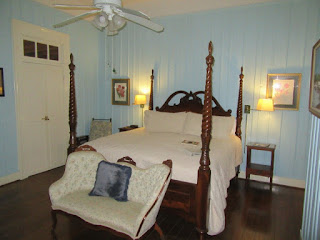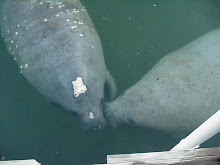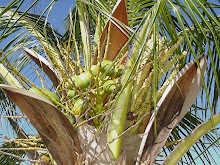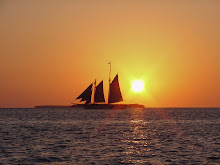Friday, December 31, 2021
Ode to 2021
Sunday, October 10, 2021
The Water is Wide Indeed
The last time (April of this year) The Colonel and I took another vacation to Savannah, Georgia (one of our favorite places to visit), we also took a day trip to Daufuskie Island. South Carolina.
Daufuskie Island is the southernmost inhabited sea island in South Carolina and is located between Hilton Head Island and Savannah. It is 5 miles long by nearly 2-1/2 miles wide. The island is surrounded by the waters of the Calibogue Sound, the Intracoastal Waterway and the Atlantic Ocean. It is accessible only by ferry or barge.
We woke up early in the carriage house we were staying at in Savannah and drove about one hour to the ferry dock. The ferry's departure was set for 7am. The ferry ride to Daufuskie Island took roughly one hour. The water was not choppy and the ride was comfortable.
Daufuskie Island is home to just over 400 full-time residents. There are environmental preserves, private communities, resorts, Gullah houses, a winery, a lighthouse, art and history galleries on the island. Daufuskie Island was named an historic district on the National Register of Historic Places due to its Gullah and Civil War history. The Gullah are African Americans who live in the Lowcountry region of the the United States. They still maintain some of their African culture and have a distinct creole language.
The Colonel and I zipped up and down the island in our electric golf cart, ever mindful of how much power reserves we had. The little red bars on the dash kept us informed. We stopped by the winery and the lighthouse.
Saturday, October 9, 2021
Our Liberty Tree
This morning, with gray clouds looming, The Colonel and I attended a dedication for our local Liberty Tree.
The original Liberty Tree was in Boston, Massachusetts (1646-1775) near the Boston Common. Years before the American Revolution, in 1765, colonists staged the first act of defiance against British government at the tree. The tree became a rallying point for the growing resistance of rule of Britain over the American colonies and the ground surrounding it became known as Liberty Hall. The tree was felled in August of 1775 by British loyalists.
My Daughters of the American Revolution (DAR) chapter sponsored the tree dedication. We had commemorative partners involved too; a local bank, a local funeral home, a local boy scouts troop, local chapters of the Sons of the American Revolution (SAR), the local chapter of the Children of the American Revolution (CAR) and of course the county.
One of my chapter's Honorary Regents was the Mistress of Ceremonies. She was the one who spearheaded the whole tree dedication from conceptual idea to actual event. Great job Debi!
The Boy Scouts lead the Pledge of Allegiance followed by the singing of the National Anthem by a young woman named Marcella Brown.
A Proclamation of Charlotte County Board of Commissioners was read by Commissioner Stephen R. Deutsch and presented to Debi.
Other speakers followed (thankfully they kept it short, the skies looked threatening and a couple drops of rain fell): the FL SAR Southwest Regional V.P., the FL DAR Great SW FL Regents Council President, the Charlotte Chapter SAR President, my chapter's Regent, President of the CAR, the SAR Chaplain General and Caloosa Chapter SAR President.
Young Jordis, President of the CAR giving her speech (she wrote it herself) at the dedication.
After all the speeches, it was time to dedicate the tree. Two Boy Scouts unveiled the stone plaque.
Finally, Marcella Brown sang God Bless America and then a benediction was given.
Below is a photo of me and some of the other ladies from my chapter surrounding the Liberty Tree.
Here is young Jordis in her colonial dress...isn't she cute?
Friday, September 3, 2021
The Little Town of Darien, Georgia
In April of this year, The Colonel and I took a little vacation. We visited Savannah, GA, Daufuskie Island, SC (more on Daufuskie Island later) and the little town of Darien, GA.
We had been through Darien back in 2011 when we visited Fort King George but this time we wanted to stay overnight. We booked a room at the lovely Open Gates Bed & Breakfast.
Zach, owner and chef (he had fresh chocolate chip cookies waiting for us) of the B&B, welcomed us to the beautiful house built in 1876. He told us that we were his only guests during our stay there (there are five guest rooms available). Zach gave us a tour of the house (to include the kitchen) and told us that we had full run of the place (just turn out lights and lock the front door before we went to bed). We had booked the Island Room.
The Colonel and I dropped our things off in our room and then went for a walk in town. Darien is on Georgia's coast at the mouth of the Altamaha River and is about 50 miles south of Savannah. It is the second oldest (Savannah is the first) planned city in Georgia and was originally called New Inverness.
Darien was founded in 1736 by Scottish Highlanders who were recruited by General James Oglethorpe (he founded the Georgia Colony in 1733 with 114 colonists in Savannah) to act as settler-soldiers to protect the Georgia Colony from the Spanish in Florida.
General Oglethorpe visited New Inverness (Darien) in 1736 and the marker below marks the spot where he had his shelter beneath the oak tree (just a stump remains) while visiting.
We walked in the little town of Darien and had a nice dinner in a restaurant along the Altamaha River. There was a baby gator in the river outside the restaurant. There were also boats moored along the river.
I took some photographs of some of the pretty houses in Darien as we walked after our dinner.







































































































